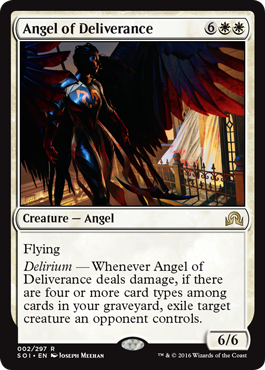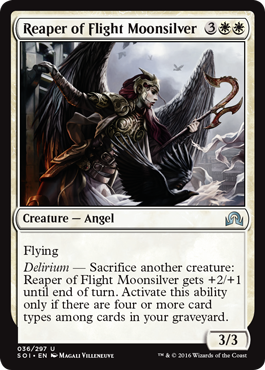This week we’re going to take a look at the history of one of Magic’s iconic creature types: Angels. They’ve been with the game since the very beginning as part of Richard Garfield’s creation, and they’ll be front-and-center as the angel Avacyn and her cohorts serve as a main focal point in the story of Innistrad. But there’s more than meets the eye when it comes to Angels, which can be a controversial topic for several reasons. Today we’ll take a look at the history of these creatures in the game of Magic.
A Brief History of Magic’s Angels
The earliest days of Magic actually only contained two Angel creatures. If you search Gatherer now you’ll find a third, which is Gabriel Angelfire, but Gabriel became an Angel as part of the Grand Creature Type Update. So in the beginning there were only two:
These two became so iconic so quickly that they have appeared in a combined twenty-one Magic products including four where they appeared together. The art for Douglas Schuler’s [casthaven]Serra Angel[/casthaven] is among the most well-known in the game’s history. The art on Anson Maddocks’s [casthaven]Fallen Angel[/casthaven] does not get the same reverence. Why is that? Is it the voluptuous cleavage on a piece of fantasy art from the early 90’s in a game that was predominantly played by teenage boys? Survey says: most likely yes.
Over the four-year span from 1995 to 1998, between Ice Age block and Tempest block, Wizards added seven more Angels to the game along with two creatures who would be given the Angel type in the Grand Update. The theme of these Angels was often protection of some sort or avenging. The ranged from the very powerful to the laughable. An interesting note is that very few of them had sexual artwork despite them all being women. The most entrancing of them would have been the buxom [casthaven]Selenia, Dark Angel[/casthaven].
In 1999 the population of Angels exploded. Urza’s block included a whopping eight angels on its own and another four creatures who would be given the Angel type in the future. Urza’s block had a bit of an angelic sub-theme as Serra herself was a part of the Urza story. Her realm was a plane full of angels, some of whom helped Urza in the battle against Yawgmoth and Phyrexia.
This was perhaps the beginning of the sexualization of Angels in Magic. They were not just protectors or avengers anymore. Many of them were, no doubt, still the traditional avenging-type of Angel such as [casthaven]Serra Advocate[/casthaven] and [casthaven]Sustainer of the Realm[/casthaven]. A few artists however were more interested in different aspects of angelic beauty.
I knew people who collected foil copies of [casthaven]Tormented Angel[/casthaven] for reasons which should appear obvious.
Another 15 Angels were printed in the next few years in Mercadian Masques block, Invasion block, and Odyssey block. As the story of Dominaria reached its climax we got some very interesting takes on Angels including our first mono-black Angels since Legends. [casthaven]Crypt Angel[/casthaven] and [casthaven]Desolation Angel[/casthaven] were both new takes on the idea of vengeful angels and their artwork reflected the kind of twisted perspective of the angelic form that Innistrad may have.
The Angels of this time period were mostly armor-clad warriors depicted in battle, such as [casthaven]Angel of Mercy[/casthaven] and [casthaven]Blinding Angel[/casthaven]. One of the most iconic vengeful angels of this age of Magic was [casthaven]Lightning Angel[/casthaven], who was so popular she made a return appearance years later in Time Spiral. However, we also continue to see the appearance of the Douglas Schuler school of big-breasted angelic beauty and a somewhat new trend of scantily clad angels. This was a time in illustration when it was popular for female armor to include increasingly more skin and decreasingly less armor.
Onslaught block, from late 2002 to mid-2003, only introduced two new angels to the game but they became incredibly important to the future of Angels in Magic.
Akroma redefined what it meant to be an Angel in Magic and perhaps there is still no more iconic creature in the game than [casthaven]Akroma, Angel of Wrath[/casthaven]. Even though she has not made an appearance on cardboard in a Standard-legal set since Time Spiral, and hasn’t appeared in a supplemental set since From the Vault: Angels, she is still insanely popular and is a very common cosplay selection.
The next three blocks (Mirrodin, Kamigawa, and Ravnica) only brought us six new Angels, which were completely absent from the world of Kamigawa. At this time Angels were very popular thanks to Akroma but they were not an iconic creature that was printed as regularly as they are today. As art and illustration techniques continued to improve, the depictions of Angels became more distinct. Ravnica block brought us two perfect examples of Angels from the illustrative school of “less is more” when it comes to female armor.
The Angels of this time period are much more interesting than just avenging or defending. These are very powerful creatures. [casthaven]Platinum Angel[/casthaven] is game-changing. [casthaven]Firemane Angel[/casthaven] sees a lot of tournament play. [casthaven]Angel of Despair[/casthaven] is a reanimator staple. Angels are becoming more and more prominent as the game grows and as the design of the game matures.
Six more Angels would be introduced before Shards of Alara was released. Here we actually get the only male angel in the game, which comes from Planar Chaos, the experimental “what if” set that messed with a lot of Magic’s core rules, such as the rule that all Angels are female.
The topic of male Angels comes up a lot and for better or for worse (mostly for worse) Mark Rosewater has made it clear that this is the direction they plan to continue in. Don’t worry, the rest of these Angels included plenty of mid-riffs for those of you keeping track at home.
The mid-riff seems to have become the main component of Angel armor at this point. It’s as if mid-riffs provide a +1 bonus to defense because your opponent is too busy ogling your belly button. If there was a title to Wizards’ style guide for artists painting Angels for Magic during this time period of the mid-2000’s it very well may have been titled Mid-Riffs, Wings, and Swords: How to Draw an Angel for Magic: the Gathering. That was my working title for this post, but it seemed a bit wordy.
24 more Angels will be printed beginning with Shards of Alara and ending with Magic 2012, the set preceding the original Innistrad. Many of them, like Baneslayer Angel, are the cherished avengers of battle we have come to know and love. The Phyrexians will bring us a new generation of twisted angelic beauty in [casthaven]Chancellor of the Annex[/casthaven] and [casthaven]Shattered Angel[/casthaven]. The mid-riffs are there, but they seem few and far-between, only appearing on [casthaven]Deathless Angel[/casthaven], [casthaven]Angelic Arbiter[/casthaven], and [casthaven]Linvala, Keeper of Silence[/casthaven].
This all brings us to Innistrad, Dark Ascension, and Avacyn Restored. This block would contribute 15 new Angels to the multiverse, many of them in the angelic-focused final set in the block. These 15 creatures including only 9 swords and an astonishing zero mid-riffs. I have to say I was impressed. The set that has had the biggest focus on Angels since Urza’s block was successful in re-capturing the spirit of the Angel of battle instead of the Angel of teenage fantasy.
Don’t get me wrong, we’re still seeing a lot of stereotypes of female beauty here, but we’re not seeing the kind of sexual representations that were prevalent in the early-to-mid 2000’s. 13 more new Angels were introduced after Avacyn Restored but before Magic Origins and there wasn’t a single mid-riff to be seen. We also got our first mono-blue Angel and even stronger themes of combat for this multi-planar tribe.
Angels are white’s iconic creature. This means that nowadays almost every set will have a rare or mythic mono-white Angel. Magic Origins, Battle for Zendikar, and Oath of the Gate Watch brought us a half-dozen new Angels with no mid-riffs in sight. Now, Shadows Over Innistrad is on the horizon, and Angels will once again play a major theme. Will this trend continue?


Impressively enough we may be seeing yet another progressive trend with Angels: the absence of prominent breast armor. One of the plights of women in combat in fantasy art has been armor that accentuates the breasts. Unfortunately, another theme has remained constant throughout the years: these Angels mostly have the bodies of Victoria’s Secret models.
Angels in Magic are not perfect, but it’s easy to see the progress that has been made in their depictions. Angels serve a very important role in the multiverse. They are an all-female tribe of very powerful warriors. They serve as a role model to the young children who play the game that there is strength and power in being female. However, I hope that the next generation of Magic’s Angels can make some progress in the realm of body types. Where are the warrior angels who are muscular, and have physical strength? We have seen many modern franchises have success with characters who are portrayed this way such as Game of Thrones’s Brienne of Tarth.
What We Learned is a weekly feature here at Hipsters of the Coast written by former amateur Magic Player Rich Stein, who came really close to making day two of a Grand Prix on several occasions. Each week we will take a look at the past seven days of major events, big news items, and community happenings so that you can keep up-to-date on all the latest and greatest Magic: the Gathering community news.



